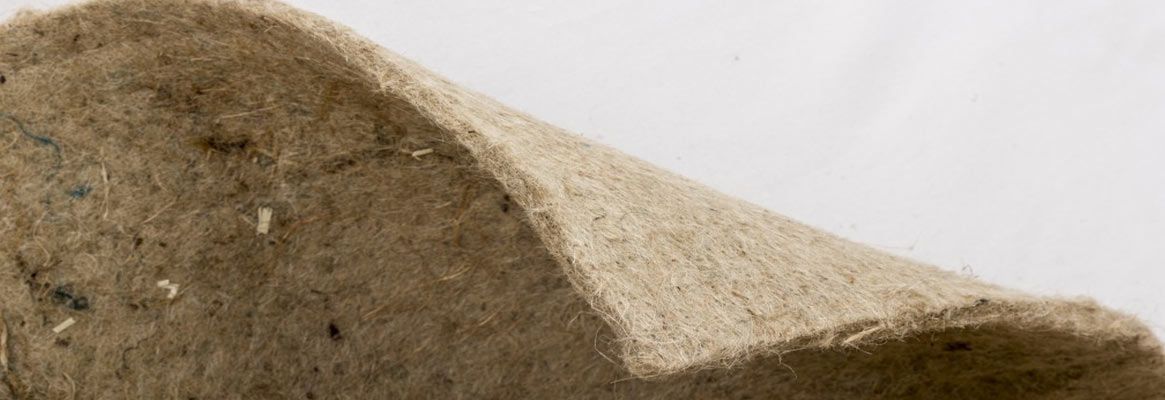Erosion Control
The two most important agents of soil erosion are wind andwater. Large tracts of land are made unusable or less productive by these two. Erosioncontrol has always been a problem and most people would accept that the problemgrows every year. For a long time, very little was done except when it was aclear case of urgent needs such as flooding or landslides. To a large degree,the problem is still more ignored than acted on. It used to be tackled on anadhoc basis using whatever was available including traditional materials likewood, rocks, cement, rubber and gabions but also rare use of coir matting andjute hessian.
It is argued by many that the use of erosion controlmeasures and materials is cost affective but no studies have been publishedthat have undertaken a cost benefit analysis. Therefore, the argument onerosion control is still largely an article of faith. There may be studies thathave not been published but IECA is trying to undertake the analysis. Theargument for erosion control, therefore, largely still rests on public opinionand that of professionals. With the spread of environmental consciousness morepeople become convinced of the common sense argument for action.
Use of materials is determined, of course, by the nature ofthe problem and choice of materials divides up into the time period that theyare expected to last. Choice of materials depends on what is available and onwhat people become accustomed to. At one extreme are permanent works made fromhard materials and expected to last a long time. Cement and cement works,rocks, steel cages to hold the rocks, timber, steel nets and even rubber tyresfall into this category.
At the other extreme are Geotextiles which are an importantpart of the erosion control materials market. They too are divided by theexpected longitude of their life as well as other characteristics. Advances intechnology and consequently materials development has allowed an increasingrole for geotextiles with different plastic structures that have been developedusing large research and development budgets. But there was also a need for thecharacteristics of natural materials. In the way of an illustration, blanketscan be made of straw, wood, waste fibres and have the advantage of also beingcheap. A basic distinction is between wovens and non-wovens and standardtechnology and machinery to produce both.
The use of geotextiles, whether they be synthetic or naturalwas being developed from the 1960s. The major effort was to come from syntheticfabric manufacturers looking for new market applications for a fast growingproduction. A number of textile manufacturers in Europe and in USA led the way. In the 1970s German exporters promoted use of geo-jute for the emergingerosion control industry but the plastic industry was also looking for end useapplications that they could cater for and targeted sacking, carpet backing andgeotextiles.
The plastics industry took action in the above areas whereboth, natural and synthetic textiles were applicable. The two globalgeosynthetics industry leaders today are Propex from USA and Tencate from Europe, the product of consolidation in the industry, but there are many others ofsubstantial scale. Both come from a polymers background. Propex has diversifiedinto carpet backing cloth (CBC), geotextiles and concrete reinforcement.Tencate have diversified into geotextiles, artificial turf, protective clothingand other technical fabrics. The two have a turnover in hundreds of millions ofdollars per annum. They both emphasise product development and a balancebetween volume and product differentiation. Between the two of them, theyaccount for one third of all geosynthetics and 57% of USA and Europe sales of geosynthetics combined.
It is very difficult to quantify the market. All we have to go by is a square metre figure for geotextiles that is quoted without a clearly identified source. It is not clear what it covers and is not based on primary research. From this per square metre figure, which I estimate at 2 million sq m, another set of assumptions have to be made on average weight per square metre and the weighting of such a figure is not known, but I guess estimate as being one million tons.
Natural Fibres
Jute geotextiles were initially promoted in Germany and their partners in USA. Again, producers in India and Bangladesh could only look on with envy. Manufacture could be in India but the profits were in marketing. The margins were far higher than for traditional jute products.
The geosynthetic industry often agreed to distribute natural fibres as well to be able to offer a full range of products but their primary interest was and is overwhelmingly in promoting synthetics. Again, it is difficult to quantify but assuming a one million ton geotextiles figure, and similar figures I have estimated in the past, it is possible to try to give some sort of quantitative guidance.
By 1976 some 5,000 tons of jute were being sold as geotextile in the USA and assuming 10,000 tons globally, accounted for 2% of the global market segment. Jute was acting as a trail blazer for natural fibres in the sector.
Today, some 20,000 tons of jute is being used for geotextiles and it accounts for just under 2% of the market segment since the market has doubled since 1980. The growth in use of jute has been significant and is part of a greater share for natural materials. The main driver has been the unique natural characteristics of the fibre.
That would be very impressive were it not for the far more impressive market sales for coir. In contrast to the very limited promotion of jute for geotextiles, there have been a series of efforts to research the market and promote use of coir. It started off with looking at geotextiles as one of the high value export possibilities being looked at for coir. With time it became apparent that it was the most promising area and has taken coir from virtually negligible market share (some white coir netting) to around 5.6%, nearly three times the tonnage of jute being used.
Natural materials have gained a great deal during this period as geotextiles. From a paltry 3% in 1980, natural materials today account for 15% of the geotextile market. There is some substitutability between the natural materials with straw and wood fibres far cheaper than either coir or jute. But the materials also have unique characteristics and there is certainly no competition between jute and coir although palm fibre being developed in Malaysia is able to marginally compete with both, jute and coir but offers yet another natural material albeit with little known unique qualities.
Coir promoters have increased the range of product-market applications. White fibre nets that sought to imitate geo-jute have led to cheaper brown fibre nets, matting and logs and pillows. A major contribution was made by the Federal policy in Germany of insulating public buildings that led to stitched blankets of coir seeded with perennial grass. Stitched blankets have proven very popular with geotextile buyers and have accounted for a great deal of the success of coir.
The geosynthetic industry is facing a crisis due to the far higher feedstock prices as well as low profitability for the plants in the USA and Europe. In any case, there is a strong and growing preference on the part of many to use natural bio degradable and sustainable materials. However, distribution of coir is poor when compared to synthetics and that of jute is very bad indeed.
Jute has been marketed and promoted very poorly to the geotextile industry and there has been relatively little product development in the past. There are understandable reasons for this but it is also clear that there is very considerable scope for increasing market penetration and sales for jute provided the jute industry is interested and willing to do so.
Reasons for poor jute performance
Geotextiles represent a substantial end use application area of the erosion control market. Over 2 million square metres (one million tons valued at $2.25 billion retail) are being used. It is also clear that although the market developed well in industrialised countries of North America, Europe, Far East and Australasia, the market has by no means reached saturation and only stands in the foothills of the potential global development.
The share of natural fibres in the geotextile market has increased dramatically due to considerations of sustainability and biodegradability as much as appreciation of the qualities and applicability of natural fibres for control of soil erosion and landscaping. But within this increased share for natural fibres jute has gained less than proportionately.
The principal reasons for this include:
- The existence of a lucrative protected and growing Indian market,
- Preferential treatment accorded to rice in policy in Bangladesh,
- Virtual collapse of distribution,
- Lack of market information,
- Virtually no market development,
- Very little product development,
- No promotion after the 1970s.
The main reason is that those who could have acted to market and promote sales had not enough incentive while those who wanted to do so probably did not have the information, or the funds to do so.
The lack of marketing effort is not confined to geotextiles. There appears to be a more general weakness and the 7 points above would apply to most export jute application areas. They sum up the situation for jute.
At the beginning, the growth of domestic usage of jute had been welcomed as a way of minimising the affect of loss of export markets. But today, India is by far the biggest consumer and the local market is so lucrative that there is little incentive to put in the marketing effort to export. In India, critics have argued that it is the protection afforded by regulations on packaging but this would not explain why the same is true of Pakistan. In the case of the latter, there is no protection or subsidy but market demand is sufficient to afford a lucrative sanctuary. Bangladeshi consumption is rising and china, which had phased jute out is importing increasing amounts.
In contrast, with coir we have had:
- Substantial increased production,
- Export based development,
- Distribution initiatives by producers,
- ITC market studies and market development,
- Product innovation,
- Promotion by machinery manufacturers,
- Local processing in consuming markets.
Development potential
The rate of growth of the market is reported by industry sources to have eased in recent years. But the market these sources were referring to is that in Europe and USA. What it did not take into account is the emergence of new markets in South America, Africa and Asia. These new markets, excluding China, India, Korea and Japan, today probably account for over 120,000 tons of geotextiles and without those exceptions, over 330,000 tons. Growth prospects in Asia are going to be an important future factor.
Therefore, the expectation is that current markets will continue to grow as well as new emerging markets that offer long term potential in addition to current markets. Unfortunately, there has been little effort to promote jute in these markets. Again, it applies to other end uses than geotextiles as well. Distribution of traditional jute products is poor to non existent.
Aside from current markets and emerging ones, there is also scope for new products in both these markets. There are good samples of new products that are being developed but the industry needs to increase product market scope that is specifically targeted at market needs. In other words, products must be developed with particular applications in mind.
Assuming that 20,000 tons of jute and over 40,000-50,000 tons of coir are being used in geotextiles, the market potential for jute is estimated at being more than double current use and possibly three times present consumption.
In fact, in all the areas where synthetics were able to take away most of the markets in the 1970s, there is potential for recovery if jute producers were interested. The problem is in supply. Potential market demand may exist for up to 100,000 tons of jute but there is no indication of it being forthcoming.
As for jute for geotextiles in particular, there is scope for use of existing products in road construction, embankments, golf courses and other landscaping. Further scope can be gained through product development which has been taking place in producing countries but is theoretical and not market led.
In the way of an illustration, stitched coir blankets gained popularity mainly because the Federal Government in Germany was persuaded that roof greening would increase insulation and lower energy consumption. It was manufactured using machinery from either of two German suppliers from Twistriggen, just outside Bremen. They saw a wider applicability for the material and production was quickly established in USA as well as in Germany and today has spread to India, Sri Lanka, Philippines and Ghana.
The important factor was that production of stitched blankets took place in consuming countries. There was thus no distribution problem and good contact with buyers. Those producing the blankets generally also sell other natural materials such as wood shaving, rice straw and others.
The coir industry has benefited a great deal from efforts on their behalf by ITC, FAO and CFC. In particular, ITC undertook a series of projects to promote coir ending up in the CFC financed project that is the subject of a Technical Paper. We first identified potential exporters who were world market standard. Then we identified important end-users willing to evaluate samples, organised the dispatch of the samples and obtained reactions. The idea was to identify gaps in between what was being produced and what was demanded in order to undertake product development that would fill the gap. The markets studied were extensive and included Australia, New Zealand, Japan, Korea, Saudi Arabia, Europe and USA. Coir producers acted on information, attended trade fairs and benefited from good organisation of marketing.
Market Development
Although the USA remains the most important market for geotextiles, Asia has become comparable, followed by Europe and South America. In all these markets it is important to look at the specifics of demand in particular national markets, barriers and distribution. It is important to undertake detailed market research covering more markets than in the past.
All the materials stand to benefit from growth in the markets for erosion control products. Polypropylene stands to benefit the most and it is likely to be pp from India or China as much as if not more than from USA. Natural materials are increasingly preferred wherever they can meet needs as much as synthetics. Then there is competition between natural materials where they can be substituted for one another and the competition takes the form of price.
Jute, on one level, is in competition with other materials: with synthetics and other natural materials. But on another level depends on its unique characteristics and how far these are translated into products. There is a limited range of existing products that is well known in most markets. However, there are other products, such as the ones which have been sent to participants as samples that have been developed but are not widely known or accepted in markets as yet. Finally, there are other products, to be made of jute or in combination with other fibres that should be developed. The key thing is to make sure that product development work targets objective needs and that the ability of the product to meet those needs is adequately promoted to decision makers.
Detailed market research in national markets would identify development potential for existing jute products and the needs that jute can contribute to meeting. The producers who are interested in exporting the products should then be assisted in meeting required standards. Tests to validate performance should be undertaken in the markets and not in producing countries. The market research will also have identified optimal distribution for the products and a programme to promote them.
The spread of markets to be studied should be wider than in the past and should include North America, Europe, Asia, Australia, and parts of South America and Africa.
To read more articles on Textile, Industry, Technical Textile, Dyes & Chemicals, Machinery, Fashion, Apparel, Technology, Retail, Leather, Footwear & Jewellery, Software and General please visit http://articles.fibre2fashion.com
To promote your company, product and services via promotional article, follow
this link: http://www.fibre2fashion.com/services/article-writing-service/content-promotion-services.asp



_Small.jpg)



